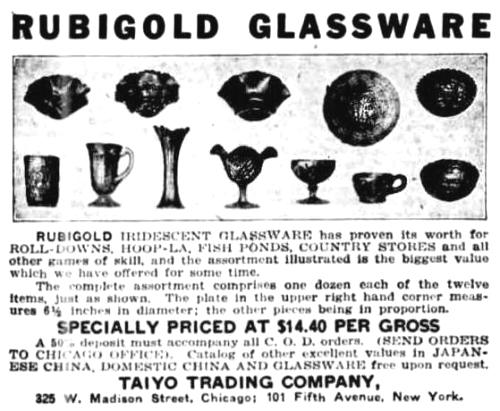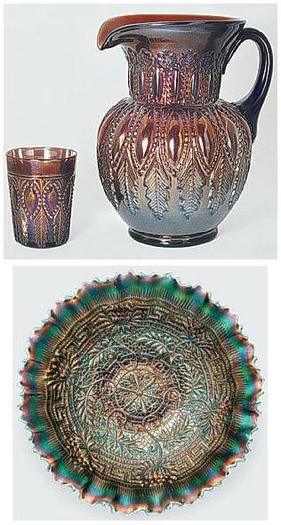NetworK Special: Pioneers #1, May 2016
by Glen and Stephen Thistlewood
|
Roll Up, Roll-Down!
On the right, the nostalgia of the early days of the Carnival Glass story, a "Roll-Down" or "Roll A Ball" sideshow, where Carnival Glass was included in the range of prizes that could be won. The connection with travelling fairs and carnivals is all a part of the magic and mystery of Carnival Glass. They were an important outlet for the Carnival glass producers, but our research shows there were many other ways that Carnival originally found its way into people's homes. Thanks to Dave Doty for permission to use this and other amazing images from this sideshow. To see the Carnival Glass that the fortunate winners were able to pick from, click on the image or go here: Roll Up, Roll-Down! Our tribute to the Carnival Glass pioneers really begins in the 1940s and early 1950s, which was when Carnival Glass began to be seen more generally as a collectible. The first authoritative article on Carnival was written by Gertrude Conboy in “The Spinning Wheel” antiques magazine in January 1952. It was a milestone for Carnival, and the glass began to acquire an identity. But hold on ... some of us may be familiar with the names Marion Hartung and Rose Presznick (more of whom later), but who was Gertrude Conboy you might ask? In answer, we'll also throw in another unfamilar name, May Plummer. |
Gertrude Conboy and May Plummer
Some people and their important contributions to Carnival Glass collecting can become lost over time, and yet in their own way they were also vital in providing the foundation of knowledge and passion that we all enjoy today.
It was as long ago as the 1940s and early 1950s that Gertrude Conboy (from Kansas) and May Plummer (from Philadelphia) shared a deep and growing interest for “iridescent glass” (Carnival) that was recorded through their fascinating correspondence. Indeed, it is thanks to another writer and researcher, O. Joe Olson that we know about this correspondence, which he described as “A remarkable insight into the Carnival heritage”.
The fascinating letters between Mrs Conboy and May Plummer were preserved by Gertrude Conboy and the information was recorded by O. Joe Olson in his 1971 issues of “The Carnival Glass News and Views” newsletter. Thanks to both of these people for recognising the significance of the correspondence and preserving it for history.
Mrs Conboy once asked: “Do you have any all clear white iridescent pieces? I have a 7 inch plate with a criss cross design of what looks like tree twigs. It has lovely coloring and cost me 35 cents.” The question just cries out for the piece to be identified by a pattern name, but such an essential structure had not been devised at that time, making for some difficult discussions!
Read more about the intriguing story of Mrs Conboy and Mrs Plummer: The Earliest Carnival Pioneers.
An Order and a Structure
An Order and a Structure
|
Back in those early days of collecting, some amazing deals were offered. Contemporary reports indicate that Carnival was so plentiful then, that it was usually sold at auctions by the basketful! One Pennsylvania dealer reputedly had a large table of “assorted pieces priced at ten cents each or three for twenty-five cents.” But even though the glass was readily available, there was no order, no commonly accepted vocabulary for collectors to use and refer to.
Early collector Phil Garrison describes the groundbreaking event that changed everything … If it had a bird on it … it was a Bird pitcher. If it had a grape on it … it was a Grape pitcher. It was all just Carnival at that time, no fancy names, only dark and light … when Mrs Marion Hartung came out with her first book (in 1960), calling pieces and patterns by NAME, Carnival Glass really took off! (Phil Garrison in O. Joe Olson’s “Carnival Glass News and Views, 1968). Left: a "Bird pitcher" and a "Grape pitcher". Fortunately, thanks to the work of Marion Hartung and Rose Presznick, they now each have a pattern name to identify them: Singing Birds and Imperial Grape. |
|
Rose Presznick and Marion Hartung We wrote about these two ladies in our trail-blazing feature back in 1999 (in our printed NetworK), describing them as "Carnival Glass Pioneers". Both articles are part of our "Blast From The Past" series. Rose Presznick explained in a 1966 newspaper interview, how she had acquired her first twelve pieces, writing that they were from her “great grandmother’s china cabinet where they had been stored since coming from a passing road show as a prize in a test of skill”. That comment reminded us of a 1922 ad (shown right) that we found in "The Billboard" (a trade magazine): it shows that "Rubigold Iridescent Glassware" (Carnival Glass) had established itself in the fairs/carnivals and similar trades. The image itself is poor, but it gives a great perspective on the prizes available to the winners of Roll-Downs and other "games of skill". Surely, the glass in the ad is all Carnival from Imperial: the plate (top row, second from the right) looks like a small Imperial Grape plate and the ruffled comport (centre, bottom row) looks like the same pattern. The handled mug on the bottom left certainly looks like Chesterfield. In an interview in 1967, Mrs Presznick described how, in the |
|
1930s, she had begun to make trips to “the glass company locations where they had once made Carnival Glass. Going from house to house or from farm to farm with two small pieces of glass, I showed them what I was hunting and asked if they had any.”
Marion Hartung was familiar with antiques, especially glass, china and silver, as her parents had owned a jewellery store, and she was drawn to iridescent glass whilst she hunted for her first passion, American Pattern Glass (EAPG). It's not very well known that in the early 1970s, Marion wrote a column about Carnival in The Mid-America Reporter. Uniquely, we have reproduced them on our website, Carnival Glass Worldwide, thanks to the generosity of Ray Steele. Click on the image on the right to read these fascinating contemporary insights into the early days of organised Carnival glass collecting. |
Their books
Both ladies launched their own series of books on Carnival, naming patterns and providing information on the glass. Confusingly, many patterns were given different names by the two women but over time, the Hartung names prevailed and are the familiar ones collectors use today.
Both ladies launched their own series of books on Carnival, naming patterns and providing information on the glass. Confusingly, many patterns were given different names by the two women but over time, the Hartung names prevailed and are the familiar ones collectors use today.
|
The picture below shows the contrasting drawing styles of the two ladies.
Left to right: Marion Hartung (Poppy Show) and Rose Presznick (Poppy Delight), and the real thing, a Classic Imperial Poppy Show vase in marigold. On the right are examples of how the two ladies saw patterns differently in naming them. Top: Beaded Jewel and Leaf (Presznick) or Perfection (Hartung). Below: Mums and Greek Key (Presznick) or Embroidered Mums (Hartung). Both pictures are courtesy of Dave Doty.
In our research since 1999, we have discovered an amazing wealth of information about these two very special Carnival Glass Pioneers. It includes the brilliant series of writings by Marion Hartung herself from the early 1970s, and an array of photos from Rose Presznick’s 1977 Auction and her amazing Carnival Glass Museum. |
As there is so much information, each of these ladies has a "master page", with links to more articles: investigate as much as you want, and maybe you will return for more! Here are the links:
We hope you have enjoyed this NetworK Special. Do take a look at the unique information elsewhere on our website. We most certainly enjoyed researching it and recording it for Carnival Glass posterity!
If you have missed any issues of NetworK, read them all here: Back Issues
If you have missed any issues of NetworK, read them all here: Back Issues












